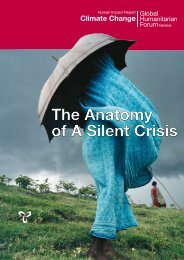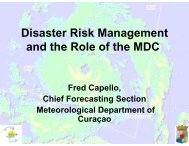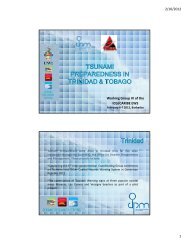Poverty Reduction Strategy Paper - UNDP Barbados and the OECS ...
Poverty Reduction Strategy Paper - UNDP Barbados and the OECS ...
Poverty Reduction Strategy Paper - UNDP Barbados and the OECS ...
You also want an ePaper? Increase the reach of your titles
YUMPU automatically turns print PDFs into web optimized ePapers that Google loves.
2.1.3. Trends in <strong>Poverty</strong> – Education, Labour <strong>and</strong> Agricultural Participation<br />
Education:<br />
There is an inverse relationship between poverty <strong>and</strong> level of education attained.<br />
There are four (4) formal levels of education offered in SVG by both <strong>the</strong> public <strong>and</strong><br />
private sectors to <strong>the</strong> age range 3-18 years: Pre primary, primary, secondary <strong>and</strong><br />
tertiary.<br />
Pre primary education is primarily a private sector led activity with some government<br />
assistance in <strong>the</strong> form of teacher training <strong>and</strong> provision <strong>and</strong> a subvention. Over <strong>the</strong><br />
years, less than 25 percent of <strong>the</strong> age group 2.5 – 3.5 years has accessed education at<br />
this level. The Ministry of Education confirms that <strong>the</strong>re is a strong correlation<br />
between access to pre-primary education <strong>and</strong> performance at <strong>the</strong> primary level. Data<br />
from <strong>the</strong> Common Entrance examination over <strong>the</strong> period 1991-2000 show that just<br />
about one third of those who write this examination gain access to any of <strong>the</strong> 21<br />
secondary schools in <strong>the</strong> state. Given <strong>the</strong> number of children who succeed at this<br />
examination, tracer studies are urgently required to verify <strong>the</strong> correlation indicated by<br />
<strong>the</strong> Ministry <strong>and</strong> to address <strong>the</strong> situation.<br />
Table 3: Common Entrance Passes 1991 - 2000<br />
Total<br />
c<strong>and</strong>idates<br />
Successful<br />
c<strong>and</strong>idates<br />
Final SVG I-PRSP Revision June 2003<br />
1991 1992 1993 1994 1995 1996 1997 1998 1999 2000<br />
2,507 2,572 2,602 2,498 2,987 2,798 2,808 2,699 2,660 2,558<br />
901<br />
993<br />
922<br />
912<br />
1,256<br />
1,066<br />
% pass<br />
36 37 35 37 42 38<br />
SOURCE: Statistics Department, Ministry of Finance <strong>and</strong> Planning<br />
The common entrance <strong>and</strong> school leaving examinations provide <strong>the</strong> main access<br />
routes to secondary education <strong>and</strong> more girls than boys gain entry, though <strong>the</strong>y are<br />
evenly represented at <strong>the</strong> primary level.<br />
Table 3 shows <strong>the</strong> number <strong>and</strong> sex of those accessing secondary education; while <strong>the</strong><br />
number has been slowly increasing over <strong>the</strong> years a large percentage of <strong>the</strong> student<br />
population does not attain secondary education.<br />
Table 4: Number of Secondary School Children enrolled by sex <strong>and</strong> Year 1991 -2000<br />
1,109<br />
39<br />
1,202<br />
45<br />
1,253<br />
Sex 1991 1992 1993 1994 1995 1996 1997 1998 1999 2000<br />
Male 2,765 2,956 2,917 2,985 3,061 3,060 3,139 3,181 3,300 3,379<br />
Female 4,178 4,218 4,366 4,479 4,584 4,579 4,551 4,594 4,698 4,560<br />
Total 6,942 7,174 7,283 7,464 7,645 7,639 7,690 7,775 7,098 7,939<br />
SOURCE: Statistics Department, Ministry of Finance <strong>and</strong> Planning.<br />
47<br />
789<br />
31<br />
15







